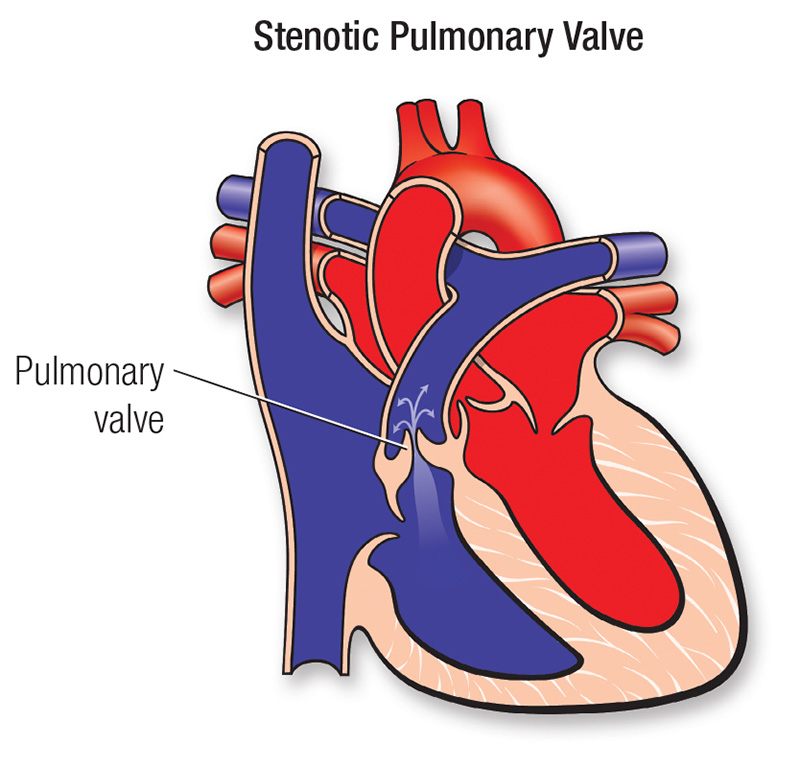
Pulmonary Stenosis
When the heart squeezes, the right ventricle (the lower right chamber) pumps blood out into the pulmonary artery, which takes the deoxygenated (impure/ blue) blood to the lungs for oxygenation. The pulmonary or pulmonic valve is located between the right ventricle and the main pulmonary artery. The pulmonary valve’s job is to prevent blood from leaking back into the heart between beats.
A normal pulmonary valve is made up of three thin sections. In pulmonary stenosis, two of the sections are stuck together or are too thick. There may also be fewer than three sections. As a result, the pulmonary valve is too narrow and the heart has to work harder to pump enough blood to the lungs. Pulmonary stenosis can be mild, moderate, severe or life- threatening.
This condition is also called pulmonic stenosis or pulmonary valve stenosis. When the blockage is below the pulmonary valve, because of too much muscle (muscular bundles), this is called subpulmonic stenosis. Also, the stenosis can occur above the pulmonary valve, in the pulmonary artery itself; this is called supravalvar pulmonic stenosis.
Pulmonary stenosis usually does not cause symptoms in infants or small children. As the child gets older, abnormal signs and symptoms may appear, including fatigue, a heart murmur (an extra heart sound when a doctor listens with a stethoscope) and, rarely, chest pain or fainting.
In rare cases, newborns have life-threatening pulmonary stenosis, which requires immediate medical attention. Severe cases of pulmonary stenosis are sometimes diagnosed before birth, through fetal echocardiography.
We usually diagnose pulmonary stenosis after a primary care doctor detects a heart murmur and refers a child to us. Diagnosis of pulmonary stenosis may require some or all of these tests:
Pulmonary stenosis can run in families, so be sure to inform us if there is a history of a murmur in other close family members.
The exact treatment required for pulmonary stenosis depends on each child’s heart anatomy. For children with mild pulmonary stenosis, treatment is not usually required. It is required, however, in cases of moderate, severe and life-threatening pulmonary stenosis.
Cardiac catheterization
During cardiac catheterization, we will insert a thin tube (catheter) into a vein in the leg, then guide the tube to your child’s heart. The catheter will have a balloon on the end of it. The balloon will be briefly inflated to open up the narrow valve, then deflated and withdrawn. Sometimes, two catheters and balloons are used.
Older children will spend one night in the hospital after this procedure, before returning home. They will also need to rest for the next few days, but then can resume normal activity. Newborns with critical conditions or children who are already inpatients may stay in the Hospital slightly longer, either in the Intensive Care Unit (ICU) or the ward.
Surgery
In rare cases, surgery is required to treat pulmonary stenosis. Surgeons will cut open or cut out the valve.
Surgery for subpulmonic and supravalvar pulmonary stenosis:
Subpulmonic and supravalvar pulmonary stenosis do not get better with cardiac catheterization, and will require surgery if the amount of blockage is moderate or severe. Surgery for subpulmonic stenosis involves cutting out the extra muscles below the valve. Surgery for supravalvar pulmonic stenosis involves enlarging the pulmonary artery with a patch.
Today, most children with heart conditions such as pulmonary stenosis go on to lead healthy, productive lives as adults. Research is also being done on innovative ways of treating pulmonary stenosis, including tissue-engineered valve replacements. A patient’s new valve would be grown with his own cells on a biodegradable mesh. Still in the research and development phase, this is an exciting treatment option for pulmonary stenosis that may be available in the near future.
Children with pulmonary stenosis require regular check-ups with a Paediatric Cardiologist. Some children must also stay on medicine and need to limit physical activity.
As your child grows, blood may begin to leak through the abnormal valve. This is called pulmonary regurgitation or pulmonic insufficiency. The blockage can also come back in some children. If this happens, cardiac catheterization can be repeated, as long as there isn’t too much regurgitation. In severe cases, additional surgery may be necessary.
We follow patients with pulmonary stenosis until they are young adults, coordinating care with the primary care physicians.
